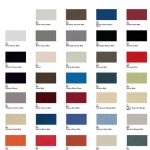How To Paint With Watercolors Step-By-Step For Beginners
Watercolor painting is a versatile and rewarding art form, known for its delicate washes, luminous colors, and captivating textures. While it can appear challenging at first glance, understanding the fundamentals and practicing consistently can unlock the potential for creating beautiful and expressive artworks. This article provides a step-by-step guide for beginners seeking to explore the world of watercolor painting, focusing on essential materials, fundamental techniques, and practical exercises to build a solid foundation.
Before embarking on the painting process, it is crucial to gather the appropriate materials. The quality of these materials directly impacts the outcome of the artwork, making informed choices a vital first step. Essential materials include watercolor paints, watercolor paper, paintbrushes, a palette, water containers, and auxiliary tools.
Watercolor paints are available in two primary forms: tubes and pans. Tube paints offer greater control over color intensity and mixing, while pan paints are more convenient for portability and quick sketches. Student-grade paints are a budget-friendly option for beginners, offering a reasonable range of colors and acceptable pigment quality. As experience grows, investing in artist-grade paints will yield richer, more vibrant results.
Watercolor paper is specially designed to withstand the water and repeated washes inherent to the medium. It is available in different weights, textures, and formats. Heavier paper, such as 140 lb (300gsm) or higher, is recommended for beginners as it resists buckling and warping when wet. Paper texture, ranging from smooth (hot-pressed) to rough (cold-pressed), influences the appearance of the paint. Cold-pressed paper is generally preferred for its versatility and ability to capture textured details.
Paintbrushes come in a variety of shapes, sizes, and materials. Round brushes are versatile for both broad washes and fine details, while flat brushes are ideal for creating straight lines and covering large areas. Synthetic brushes are a cost-effective option for beginners, while natural hair brushes, such as sable or squirrel, offer superior water retention and smooth application. A selection of brushes in different sizes is recommended to accommodate various painting techniques.
A palette is essential for mixing and diluting watercolor paints. Ceramic palettes are easy to clean and offer a smooth surface for mixing, while plastic palettes are lightweight and portable. A palette with multiple wells allows for organizing different colors and creating custom mixes.
Two water containers are necessary: one for cleaning brushes and another for diluting paint. Clean water is crucial for maintaining the purity of the colors and preventing muddy mixtures. Auxiliary tools, such as masking tape, pencils, erasers, and paper towels, are also helpful for preparing the painting surface, sketching outlines, and controlling the flow of water.
Understanding Basic Watercolor Techniques
Mastering basic watercolor techniques is essential for achieving desired effects and controlling the flow of paint. These techniques include washes, layering (also known as glazing), wet-on-wet, and dry brush. Experimenting with these techniques on scrap paper is encouraged before applying them to a finished artwork.
A wash is a flat, even application of diluted paint over a large area. It is commonly used for creating backgrounds, skies, and other expansive elements. To create a wash, begin by wetting the paper with clean water. Then, load the brush with diluted paint and apply it in smooth, overlapping strokes, tilting the paper to allow the paint to flow evenly. Avoid overworking the wash, as this can lead to uneven color and unwanted textures.
Layering, or glazing, involves applying multiple thin washes of color on top of each other, allowing each layer to dry completely before applying the next. This technique is used to build up depth, create subtle color variations, and achieve luminous effects. When layering, it is important to use transparent colors and avoid opaque pigments, as opaque pigments can obscure the layers underneath. Applying successive layers of subtly different color allows for the creation of complex shades and tones.
The wet-on-wet technique involves applying wet paint to wet paper. This creates soft, diffused edges and blending effects. To use this technique, wet the desired area of the paper with clean water. Then, load the brush with wet paint and apply it to the wet surface. The paint will spread and blend naturally, creating soft, watercolor effects. This technique is beneficial for painting clouds, foliage, and other soft, organic shapes.
The dry brush technique involves applying relatively dry paint to dry paper. This creates textured, broken lines and is useful for depicting details such as tree bark, grass, and fur. To use this technique, load the brush with a small amount of paint and blot it on a paper towel to remove excess moisture. Then, lightly drag the brush across the paper, allowing the texture of the paper to show through. Different brushes and different pressures applied to the brush will result in diverse textures.
Practical Exercises for Beginners
Practical exercises are crucial for developing skills and building confidence in watercolor painting. These exercises focus on mastering basic techniques and experimenting with different color combinations. Examples of exercises include color mixing charts, graduated washes, and simple still life studies.
Creating a color mixing chart is an excellent way to familiarize oneself with the properties of different pigments and understand how they interact. Start by selecting a limited palette of primary colors, such as a warm and cool version of each primary (red, yellow, and blue), and optionally a green. Paint squares of each individual color across the top and down the side of a grid. Then, mix each color with every other color, filling in the remaining squares of the grid. This chart will serve as a valuable reference for future painting projects. Annotating the chart with the specific pigment names used allows for accurate replication of color mixtures later.
Practicing graduated washes helps develop control over water and pigment ratios. Section off a rectangular area on the paper. Start with a saturated wash at the top of the rectangle using a single color. With each successive stroke, add more water to the brush, gradually diluting the paint. This will create a smooth transition from dark to light, demonstrating the effect of water on the intensity of the color. Repeat this exercise with different colors and gradients, such as transitioning from one color to another.
Simple still life studies provide an opportunity to apply learned techniques to create representational artworks. Start with simple objects, such as fruits, vegetables, or household items. Arrange the objects in a well-lit setting and sketch a simple outline on the paper. Then, apply washes of color, building up layers and adding details as needed. Focus on capturing the light and shadow, as well as the colors and textures of the objects. Don't be discouraged by initial results; consistent practice is key to improvement. Focusing on accurate observation of the subject matter is equally important.
Essential Considerations for Successful Watercolor Painting
Beyond techniques and exercises, certain essential considerations contribute to successful watercolor painting. These include understanding color theory, managing water control, and planning the painting process.
Color theory provides a framework for understanding how colors interact and create specific effects. Learning about concepts such as primary, secondary, and tertiary colors, complementary colors, and color temperature is essential for creating harmonious and visually appealing artworks. Experiment with different color palettes and learn how to create color schemes that evoke specific moods and emotions. Understanding the color wheel and how different colors neutralize or enhance each other is extremely beneficial.
Water control is crucial for achieving desired effects in watercolor painting. Too much water can lead to uncontrolled bleeding and washes, while too little water can result in dry, chalky textures. Practice adjusting the amount of water on the brush and learn how to control the flow of paint. Experiment with different brushstrokes and paper types to understand how they affect the water's behavior.
Planning the painting process is essential for achieving a successful outcome. Start by sketching a simple outline of the subject on the paper. Then, identify the light and shadow areas and plan the color scheme. Applying masking fluid to preserve highlights before applying washes can be advantageous. Working from light to dark is the general rule, as it is easier to add darker colors on top of lighter washes than vice versa. Allowing each layer of paint to dry thoroughly before applying the next is crucial for preventing muddy colors.
Watercolor painting is a journey of continuous learning and exploration. By mastering basic techniques, practicing consistently, and paying attention to essential considerations, beginners can unlock the potential to create beautiful and expressive artworks. Embrace experimentation, learn from mistakes, and enjoy the process of discovering the unique qualities of this captivating medium.

Easy Watercolor Painting Ideas For Beginners Step By

Easy Watercolor Sunset Tutorial For Beginners Step By

How To Start Watercolor Painting First Steps For Beginners Affair

Painting With Watercolors For Beginners The Postman S Knock

Watercolor Tutorial For Beginners Step By Purple Sunset Painting

Tutorial How To Paint A Watercolour Rose Loose Style Emily Was

20 Best Watercolor Flowers Tutorials S A Piece Of Rainbow

Easy Watercolor Painting Ideas For Beginners Tutorials Printables

Easy Watercolor Tutorials For Beginners That Art Teacher

Tutorial How To Paint A Rose In Watercolor Doodlewash
Related Posts








